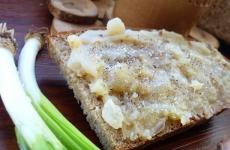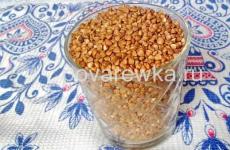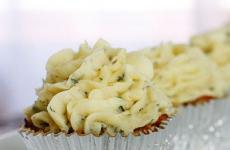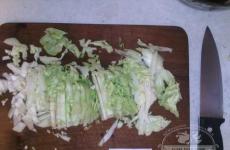Signs of spring: the first butterflies and flies. Lesson on the surrounding world "Visiting spring. Insects and birds in spring" What insects appear in April
As soon as the weather begins to warm up in March, the earliest insects – stoneflies – can be seen near the water. There is still snow around, but these creatures with transparent wings and thin antennae on their heads are already running near bodies of water. Adults are on the shore, and stonefly larvae are in the water.
A little later, with the melting of the snow, one of the main workers of the forest - ants - wake up. As soon as the snow melts from the anthill, these insects climb onto its surface to bask in the sun. And turf ants wake up only after the soil warms up a little.
Immediately after the snow melts, provided there is no frost, the first ones wake up. The bright and colorful one flies into the air first. It can be recognized by its brick-red wings, along which there are yellow and black spots in front, and blue triangles on the sides. It got its name from the fact that only its caterpillars can feed on stinging nettles.
It is believed that urticaria can predict the weather - if on a warm day it hides in a secluded place, it means it will get colder or there will be rain.
And a week after hives, lemongrass wakes up. Their females are pale yellow-green in color, while the males are bright yellow. The rest of the butterflies appear much later, because they overwinter eggs, caterpillars and pupae, which need time to turn into a butterfly. And in lemongrass and urticaria, adult individuals overwinter.
In early spring, you can hear a characteristic buzzing in the air - large bumblebees have gone in search of the first flowers. Thanks to the rapid contraction of the pectoral muscles, which causes a loud buzzing, these insects maintain an optimal body temperature of +40°C, even if the temperature outside is no more than 10°C.
The ability to maintain a high body temperature allowed bumblebees to settle in the North, where other insects simply would not survive.
Late insects
Among those who wake up for a long time in the spring are ladybugs. These small, bright insects appear by mid-April and immediately get to work protecting plants from aphids. They are easily recognized by their arched back, as well as yellow or red wings with black dots.
In May, the air is filled with harmful midges and mosquitoes, which cause a lot of trouble for both people and animals. The bites of many midges are quite painful. Then you can notice the first sleepy flies.
And at the end of spring, cockchafers wake up - large black-brown insects with characteristic whisker bristles. True, they fly for only 20-40 days, and then lay eggs underground, which develop for several years.
In spring, migratory birds fly to their native lands, animals come out of hibernation. But other, smaller representatives of wildlife are also returning. When the frosts go away and it finally becomes warm, insects wake up that have not been seen all winter.
Wintering butterflies
Different types of butterflies have different . The lifespan of some is calculated in weeks, or even days, while others can live for several years. Long-lived butterflies are able to survive winter in various stages. The crimson silkworm can wait out the cold in the form of a caterpillar; individuals of many species spend this time in the form of a pupa.
Adult butterflies also hibernate. They find secluded places for themselves in advance - they screw plant leaves to branches, from which they make a comfortable cocoon, climb into hollows and crevices in trees, and hide in abandoned buildings. With the arrival of warmth, insects wake up and come out of their hiding places.
Some species of butterflies do not fall asleep, but, like migratory birds, fly away to warmer regions for the winter. These include the admiral butterfly, which lives in Russia and spends winters in West Africa.
Mosquito on pause
With the onset of cold weather, mosquitoes that are so annoying over the summer disappear. These hide under the bark of trees that has moved away from the trunk, in or simply in dry grass. Those who prefer to live in the city spend the winter in empty premises. They can be found in abandoned buildings, in attics and basements, in tunnels of heating pipes and even in the subway. In cold weather, the mosquito's metabolic rate decreases. It’s as if he’s taking a pause so that when the warmth comes, he can take it off.
Today in the city you can find mosquitoes even in winter. The reason for such insomnia is the presence of damp, heated rooms (for example, basements with faulty pipes), where mosquitoes can breed even in cold weather.
What does the cockchafer do in January?
Numerous beetles also prefer to wait out the winter in a secluded place in order to wake up in the spring and go about their business again. Many species, including the cockchafer, overwinter in the soil, burrowing several tens of centimeters deep so that frost does not reach them. Bronzovka prefers to spend the winter in warm heaps of compost. Beetles like to sleep in the cracks of trees and under the bark for the winter.
Pretender fly
The life of some flies has already become impossible away from human habitation. They also prefer to spend the winter in what has already become their home. With the onset of winter, insects find secluded places with a cool, even temperature - balconies, basements, where they hide in cracks and remain until spring. Often in winter you can see supposedly dead flies between window frames. In fact, they have not died, but are just waiting for warmer weather to wake up and reappear.
Video on the topic
With the onset of autumn and subsequent cold weather, all life on Earth prepares for winter. The most numerous class of animals in the world, insects, is no exception. For example, some butterflies climb into hollows and under the bark of trees and into the attics of old houses for the winter. But not all insects overwinter this way. During the winter, some of them are generally in the stages of eggs, larvae, pupae or caterpillars, turning into an adult insect only in the spring, if, of course, they are lucky enough to live to see it.

Instructions
The vast majority of insects in temperate climates survive the winter by entering a certain state called diapause. Diapause resembles the state of suspended animation in vertebrate warm-blooded and cold-blooded animals (bears, hedgehogs, frogs, lizards). During diapause, insects' metabolism and other vital processes slow down. This is what helps them withstand low winter temperatures.
It is worth noting that, unlike the suspended animation of warm-blooded animals (hedgehogs, bears, shrews, moles), which can be interrupted from time to time by short-term awakenings, the “winter sleep” of insects is the deepest and requires certain conditions for its termination. As a rule, winter hibernation of insects depends on the length of daylight hours and the presence of a certain temperature regime.
The difference between the hibernation of insects and the hibernation of warm-blooded animals is that in the latter it depends entirely on the availability of food supply. It is curious that insects can overwinter at any stage of their development - from egg to imago (adult insect). Diapause occurs differently in different insect species. For example, mourning butterflies avoid freezing by adding a special coolant to their bodies (in the language of motorists - “antifreeze”).
The mourning butterfly is able to replace the water contained in its body with natural “antifreeze”, which it produces itself. It contains so-called cryoprotectors that protect all fluids and soft tissues in her body from low temperatures. Other insects generally freeze all available fluids in their bodies during diapause.
But not all insects that survive the winter cold enter a state of diapause. Social insects such as wasps, bees, termites, and some types of ants do not go into “winter sleep.” With the onset of autumn cold, these creatures go deeper into their nests, hives, and anthills. They tightly cover all entrances to their homes with leaves and other organic materials. Under the ground or in the depths of their nests, they lead a semi-active lifestyle.
Objectives: to clarify changes in plant life in spring; conduct observations of changes in the life of insects and birds; awaken students’ interest in their native nature, in caring for the environment; develop curiosity and empathy for the living world around us.
1. Organizational moment.(Musical intro - P. Tchaikovsky “Lark”)
2. Repetition of the material covered.The long-awaited spring has arrived. The streams began to gurgle, and new fresh aromas of nature awakening from winter wafted in.
What has changed in the plant world with the arrival of spring?
3. New material. Insects.As soon as the frost lets up a little and the thaw sets in, all sorts of impatient riffraff crawl out from under the snow in the forest: earthworms, wood lice, butterflies, ladybugs... Insects stretch their stiff legs.
Now the willow has bloomed - guests from all sides are rushing to the feast.
Bumblebee flew in - clumsy, shaggy, like a bear. He got excited, tossed and turned, and got covered in pollen. Children often kill bumblebees as if they were stinging insects. However, the bumblebee is much more peaceful than wasps and bees. A bumblebee family lives for 1 summer. During the winter, only the young female queen remains alive, who, waking up in the spring, begins to look for a nest for herself. If she dies, then there will be no one to start a new family. Same situation with bees
Do you think bees have enemies? Who are they?
This is, for example, the barn swallow; storks that literally fill their stomachs with bees without a break.
Ladybug, for example, destroys from 50 to 270 aphid pests per day.
Dead beetle eats carrion - he is a “orderly”.
How incredibly beautiful a meadow is (illustration) when colorful butterflies flutter over it.
What butterflies do you know?
Hives, admiral, peacock eye...- these and other butterflies, feeding on the sweet juice (nectar) of flowers, contribute to the pollination of plants. Their caterpillars do not cause harm, as they usually feed on various weeds. These butterflies are beneficial.
But there are also very harmful butterflies. Which?
This meadow moths and fall armyworms. They are nasty pests. The caterpillars of these butterflies, which are distinguished by their omnivorous and great gluttony, cause great harm.
Here he crawled out from under the ground Chafer, shook off his hard wings from the ground. What is he doing in the ground? How did he get there? Let's read about this in the textbook on page 208. Do you think these are beneficial insects?
Conclusion. Any insect requires protection from us. Why? Insect conservation receives a lot of attention; Special reserves (sites, plots) are organized for these and other insects.
What is it reserve? And we can clarify this in the “Explanatory Dictionary” (p. 75)
(Writes on the board reserve).
4. Birds.
With the arrival of spring, the forests, meadows, and fields become noisy - our guests - the birds - have arrived. Birds are divided into two groups. Which? (Migratory and wintering). Let's look at the drawing (there is an illustration on the board). Name the wintering birds. Migratory. Let's talk about birds.
Who is wearing a bright red beret,
In a black satin jacket?
He doesn't look at me
Everything is knocking, knocking, knocking. ( Woodpecker)
Its length reaches 25 cm, body weight 100 g. It climbs trees well, its legs are short and very strong, with tenacious claws, it feeds on pupae and insect larvae, and in winter on cones.
Color – grayish,
Habit - thieving,
Screaming - hoarse -
Famous person.
Who is this? ( crow) (A recording of a crow's voice sounds)
It is larger than the rook and jackdaw, but 2 times smaller crow. It's two-tone. In September-October it flies south for the winter and returns in the spring. It is known that about people who have made a mistake they say: “Oh, you crow!”, “Well, did you miss it?” However, this is a wrong opinion. Crows are very fond of shiny objects, which they strive to drag into their nest. (crow).
Who is without notes and without a pipe
He produces trills best of all,
More vocal, more tender?
Who is this?... ( nightingale)
This is a small bird, smaller than a sparrow, with inconspicuous plumage. Eats aphids and weed seeds. He sings amazingly (the voice of a nightingale sounds).
Who is this bird?
Never
Doesn't build a nest for itself,
Leaves eggs for neighbors
And he doesn’t remember the chicks. ( Cuckoo) (The voice of the cuckoo sounds).
She is smaller than a dove. It nests near songbirds, but does not have its own nest. Of the 150 species of cuckoos, only 8 do not hatch chicks. The cuckoo is very useful. It eats huge quantities of hairy caterpillars, which other birds do not feed on. Cuckoos winter in Africa. (Textbook, p. 210)
5. Bird protection.
You can read about how birds are protected in our forests and fields in the textbook on page 210, paragraph 2 and on page 211, paragraph 2
Conclusion. So, what do we need to do to make birds comfortable and safe in our forests, gardens, and fields?
6. Lesson summary. Textbook, page 212.
7. Homework.Love nature!
Love nature!
Don't burn the grass!
Don't break the bushes!
Don't throw any nasty stuff on the ground.
And nature will give you
Health and joy!
The words are written on the board:
Insects, reserve, plot, reserve, goldfinch, crow, nightingale...
In the midst of spring, when many voracious lovers of greenery appear in the world of insects, ladybugs come to the aid of plants. A ladybug is a beetle with strongly convex, bright, shiny wings with black dots. How is this beetle similar to a cow? Why did you get such a name? The fact is that in case of danger, the beetle secretes a drop of poisonous white-yellowish liquid - “milk”. This is why he got his name. Ladybugs are one of the few insects that can completely destroy insect pests. They have repeatedly brought great benefits to people by preserving plantations of tea bushes, tangerines, lemons and other agricultural crops. In our area, the cow destroys aphids - small, but very harmful insects for plants.
In the evenings in May, a large black-brown beetle with noticeable whisker bristles can be seen around deciduous trees. It’s funny to watch how, having opened his large, stiff wings, he rises into the air with a hum. This is the May beetle, or, as it is also called, the May beetle. The beetle flies for only twenty to forty days, and then lays eggs, from which larvae emerge. The larvae live and develop underground for three to four years! Only in the fourth summer do they pupate, and a beetle emerges from the pupa.

At the end of March, when there is still snow, the first spring insects appear. Near the water you can see many stoneflies - large insects with a delicate, inconspicuous body, transparent wings riddled with veins, and long thin antennae on the head. The stonefly's wings are folded like a peaked roof over its body. The larvae of this insect live in the water, and adult stoneflies live on the shore. They fly poorly and prefer to run - fortunately their slender legs allow it.
Almost all butterflies usually overwinter as eggs, caterpillars or pupae, while the wren and lemon grass overwinter as adults.
Therefore, as soon as the snow melts, we are the first to notice them. The hives are the first to wake up - a bright, motley butterfly. The wings are brick-red on top, along the front of the wing there are large black and yellow spots, and on the sides of the wing there is a border of blue triangles with a black border. It is named nettle because only its caterpillars can eat stinging nettles. It has been noticed that hives can predict the weather: if on a bright sunny day a butterfly hides in a shelter, then it means that in two hours there will be rain and thunderstorms.
Later, ten days after the hives, lemongrass wakes up. The male and female of this butterfly are of different colors, although they are similar. The female is pale yellow-green and the male is bright yellow. Lemongrass with folded wings is difficult to notice: it looks like a yellow leaf. This butterfly also has an interesting feature: if you suddenly disturb it, it falls to the ground, folding its wings and pressing its legs. Try it, notice this one!  In early spring, large bumblebees appear in gardens and parks. The bumblebee has a black body with a red fluffy collar, a shaggy abdomen and bright yellow pollen on its hind legs (the bumblebee has a special device on its legs - baskets for collecting pollen). Serious, unhurried, he busily flies around flower after flower in search of nectar and pollen. Noteworthy is the bass hum of the bumblebee, which can be heard even when it does not move its wings. Where does this sound come from?
In early spring, large bumblebees appear in gardens and parks. The bumblebee has a black body with a red fluffy collar, a shaggy abdomen and bright yellow pollen on its hind legs (the bumblebee has a special device on its legs - baskets for collecting pollen). Serious, unhurried, he busily flies around flower after flower in search of nectar and pollen. Noteworthy is the bass hum of the bumblebee, which can be heard even when it does not move its wings. Where does this sound come from?
It turns out that the buzzing is a very rapid contraction of the bumblebee's pectoral muscles. By moving its muscles, the insect warms itself. His body temperature is +40°, even if it is only +10° outside. To warm the nest, bumblebees buzz especially loudly at three or four o'clock in the morning - the coldest time. The ability to increase body temperature with such physical exercise allowed bumblebees to spread so far to the north, where there are no other plant pollinators besides them. Bumblebees live in Chukotka, Greenland, Alaska, and the islands of Novaya Zemlya.
The bumblebee is the best plant pollinator of all insects. During the day it flies around thousands of flowers. But you need to know that only pollinated plants will bear fruit. Some plants, due to the structure of their flowers, can only be pollinated by bumblebees. The value of these insects for people is great. To save as many bumblebees as possible, they even created a special reserve “Bumblebee Hills”! After all, every destroyed nest means the loss of millions of seeds of clover and other field and meadow grasses.
Bumblebees make nests on the ground. In the spring, the overwintered female sits on the ground, crawls under the foliage or into a burrow and makes cells there from a mixture of wax and pollen for future offspring.
Material taken from the site
Spring has fully come into its own: a carpet of cheerful greenery is already peeking out from under last year’s old grass, butterflies and flies have appeared, spring primroses and trees are blooming. Today I will show you photos of the first flowers and insects, taken using a lens that is not at all suitable for macro photography.
The willow continues to bloom. Although such a plant as willow does not exist for botanists, this is what some of the species of the genus Willow are popularly called - Goat willow, Acute willow, etc.
But we continue to call these fluffy pompoms willow flowers.

Other bushes and trees are blooming, for example, the American maple, on which “helicopters” will appear in the fall, blooms with such beautiful tassels.

Birds rejoice in spring. The songs of tits and finches are constantly heard.

Right there, on the edge of the forest, in the grass, small blue-violet flowers turn blue. This is probably how some of the Skullcap species blooms, but I couldn’t determine more precisely.
In the comments, this is ivy bud (Glechoma hederacea).

Not far away, next to the river, you can see a flat yellow top, on which it is not clear where the yellow flowers are, and where the yellow leaves surrounding them are, which, the further from the top, the more common and green they become. This is what the alternate-leaved spleen (Chrysosplenium alternifolium), or ordinary, looks like, so named because in folk medicine it is used for diseases of the spleen.

Nearby, among the old grass, star-shaped buttercup flowers turn yellow. This is probably the Kashubian Buttercup (Ranunculus cassubicus). They suggest that this is a buttercup anemone (lat. Anemone ranunculoides)


It grows in a river bend as a separate cushion-curtain.

In the river, where near the shore there are piles of all sorts of debris left over from high water, and where there is almost no current, water strider bugs frolic.

Nearby, a small butterfly sat down to rest on the grass, its color somewhat subtly reminiscent of the widespread and well-known urticaria, but 2 times smaller in size. This is the Variable Wing (Araschnia levana). It is so called because butterflies of different generations (spring and summer), or even simply kept in cocoons at different temperatures, look completely different. The spring form is shown here, while the summer form has black wings with a wide white stripe.

Nearby, on a nearby blade of grass, this strange furry elephant with a trunk sat down to rest. This is the Small Buzzer (Bombylius minor), in some areas listed in the Red Book. It needs a long trunk in order to drink nectar from flowers, next to which the buzzer can hover in place in the air, just like a hummingbird. And in appearance the buzzer resembles this small tropical bird. This is a good example of convergence in evolution, when completely unrelated organisms, thanks to a similar way of life, receive common external characteristics (the example of a hawk moth, which has even more similarities with a hummingbird, is more indicative here).

In the next photo there is a butterfly from the White butterfly family, most likely the Blueberry (Pieris napi), although the dot on the wing of this particular specimen is practically invisible.

And I’ll finish the selection with photographs of three spiders.


Isn't that right, handsome? Just look at his gray, furry-striped paws, which give him a very stern look, which is offset by a pair of sparkling eyes, almost like the cat from Shrek.

Elena Koroleva
Abstract of the educational activity “Insects in the spring” in the 2nd junior group
Program content:
Clarify children's knowledge about spring, the names of insects, primary colors; develop the ability to combine movements and speech.
Develop attention and logical thinking; articulation and intonation expressiveness of speech.
Cultivate neatness and respect for all living things.
Dictionary:
bumblebee, fluttered, insects, pollen, buzzing.
Preliminary work:
looking at illustrations about insects. Conversations with children about the signs of the seasons, looking at illustrations, observing while walking.
Equipment:
pictures with signs of the seasons; a stump in which insect models are placed; drawing of the sun; cardboard flowers of different colors; pictures of insects; pictures of a bumblebee hive and burrow, plumes; leaf templates, circles of different diameters, glue, brushes, napkins.
Progress of the lesson:
Guys, what time of year is it now? That's right, spring. What happens in nature in spring?
(The snow has melted, birds have flown in, grass has grown, the sun is getting hotter, the first flowers are appearing, buds are swelling on the trees).
Let's play the "Show and Tell" game.
Before you are many different pictures about the seasons, you must choose only those pictures that depict the signs of spring and talk about them.
That’s right, in the spring nature wakes up, the first flowers and grass appear, the first insects crawl out.
Guys, the sorceress spring gave us a gift, let's see what it is?
That's right, but look, someone is hiding in it. Who is this?
(Bee, bumblebee, ant, butterfly, grasshopper, ladybug,).
How can you call them all together?
(Insects).
To protect themselves from the winter cold, insects hid in stumps and slept under the bark all winter until the warm spring. Let's take the insects and put them closer to the spring sun.
(Children take one insect from the stump, name it and put it in the sun).
How are all insects alike?
(They are small and have six legs).
What do insects eat?
(Grass, pollen).
Look how many colorful spring flowers have bloomed. Tell me what color flowers you see here?
(Red, yellow, blue, etc.)
Well done, let's help the insects move to the flowers. Riddles will help us in this task. Listen to the first riddle:
Moved around the flower
All four petals
I wanted to rip it off
He took off and flew away. (Butterfly)
– Let’s plant it on a blue flower (the child shows the desired flower and puts an insect on it).
Not a bird, but with wings.
Flying over the flowers
The honey is collected. (Bee)
- Her flower is red. Where do bees live? (In the hive).
Plump, furry,
Flying for sweets. (Bumblebee)
- Its flower is yellow. Where do bumblebees live? (In burrows underground).
We are now going to play the game “Bees and Bumblebees”.
The girls will be bees, they will live in a hive, right here (picture of a hive). When we call them, they will fly around the flowers, collect honey in the flowers and buzz: w - w - w. And the boys will be bumblebees, they will live in minks, right here (picture of a mink). When we call them, they will also fly, collect honey and say: z-z-z. If it starts to rain, you need to quickly hide in your house.
Well done, everyone was attentive bees and bumblebees.
Do you hear, it seems like someone is crying? Oh, it's a caterpillar. Where does the caterpillar live?
(In the grass, on the leaves).
Let's make girlfriends for the caterpillar, and she won't be so bored! Take each green leaf on which we will plant it, and sit down at the tables. Look, you need to smear circles from large to small and glue them onto a piece of paper. If you understand everything, get to work.
Look, the caterpillar is happier, she really liked her new friends. Well done boys!






